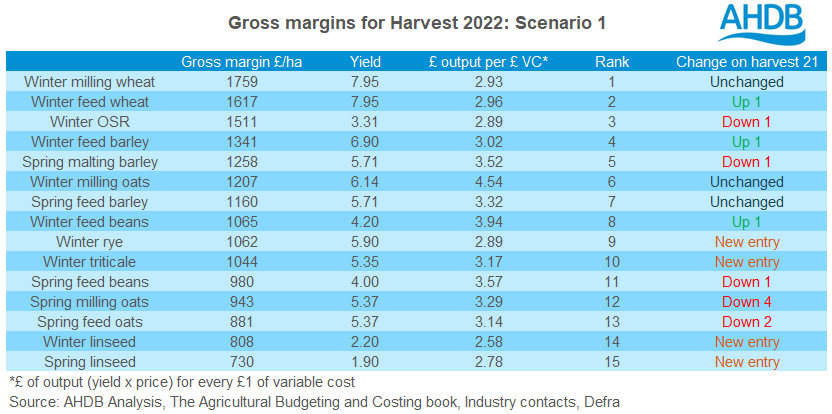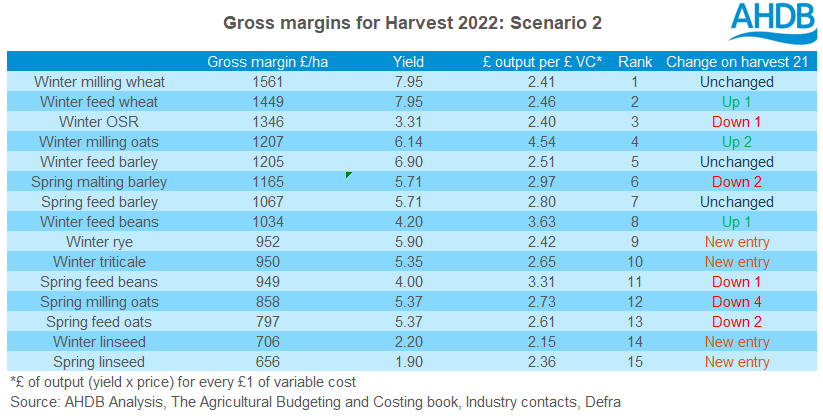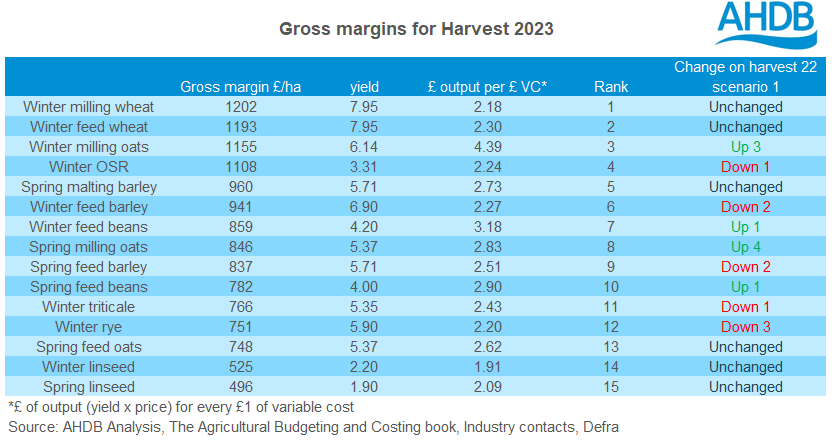Analyst Insight: How are margins looking for harvests’ 22 and 23?
Thursday, 19 May 2022
Market commentary
- Markets saw some price corrections yesterday, following the UN’s efforts to restore Ukrainian grain shipments and Russia’s forecast ample supplies.
- As such, yesterday’s UK wheat (May-22) price fell £25.40/t from Tuesday, closing at £333.10/t. New crop futures (Nov-22) closed at £340.10/t a loss of £11.40/t over the same period. Both contracts followed declines seen in Chicago and Paris wheat contracts.
- Paris rapeseed futures (Aug-22) saw a €44.75/t decline, closing at €831.25/t. The Nov-22 contract closed at €819.75/t, a similar decline of €41.50/t from Tuesday’s close. News that Indonesia will be lifting it’s palm oil export ban from Monday is providing price pressure across the whole oilseed complex. Germany have also presented legislation that by 2030 the plan is that they will not use any food based biofuels.
How are margins looking for harvests’ 22 and 23?
We are fast approaching harvest 22 and looking now to harvest 23 for cropping decisions, but the cost and margin picture looks very different to this time last year.
UK feed wheat new crop futures (Nov-22) closed yesterday at £340.10/t. This is almost double the price from this time last year, where new crop futures (Nov-21) closed at £178.75/t (18 May 2021). A tight supply and demand balance for grains across the board, intensified by the outbreak of war between Russia and Ukraine, has driven values to record highs in recent months.
Though input costs have been rising too. This season-to-date (Jul-Apr), UK produced AN (34.5% N) prices have averaged £601.00/t, up 138% (+£349.00/t) from the average over the 2020/21 season.
Today, I explore how this changing picture has impacted on gross margins.
The aim of these figures is to not directly indicate how much profit can be made by each crop, because variable costs will differ by farm. It is more to understand a difference in profitability by year, and to support decision making for harvest 23 cropping. These figures may also give an indication of what the UK planted area may look like too.
Harvest 22 – costs high but prices higher…
Using two scenarios, profitability between crops can be assessed for harvest 22. For many businesses, the story will rely on price paid for fertiliser and this impact on variable cost for harvest 22.
The first scenario takes an average season-to-date for UK produced AN 34%, Muriate of Potash and Triple Super Phosphate. The second scenario takes the top recorded prices this season for these three fertilisers, to compare profitability.
Perhaps to no surprise with strong global wheat values supporting UK feed wheat futures, milling wheat and feed wheat are top performers in both scenarios. Though the difference in the price paid for fertiliser makes a large difference in gross margin.
For the milling wheat premium for harvest 22, this uses an average for the 2021/22 season to date. This season’s average has been higher on the year due to the current tight supply and concerns around milling wheat availability. As such, milling wheat gross margins look attractive for harvest 22 especially in scenario 1.
Oilseed rape follows closely behind, considering high prices supported from inelastic demand for rapeseed and rapeseed oil. However, new-crop (Nov-22) prices are lagging previous May-21 highs, as supply is expected to improve globally next season. However, crush demand is set to be firm also, which could keep balances tight in the first half of the marketing year.
Linseed, however, is understood now to be trading separately to oilseed rape. As a result, this crop may not have benefitted to the same extent from rapeseed’s price highs.
Harvest 23 – prices lower than harvest 22, but costs to remain high?
Looking to harvest 23, costs look to remain high. Nov-23 UK feed wheat futures prices too look to be firm. Yesterday, the contract closed at £280.20/t. Though is this enough to offset high prices?
Using AHDB forecasts for potassium and phosphate costs, and using CF fertiliser’s latest price for September delivery, margins look to be squeezed compared to harvest 22.
Even if there was a timely end to the war in Ukraine, destruction to Ukraine’s export infrastructure will cause longer term challenges. This adds to the global tightness outlook for the medium term, still further supporting 2023 wheat prices. As such, milling wheat and feed wheat remain top performers.
However, the difference between the two looks narrower than harvest 22. For harvest 23, we have used a 5-year average premium to calculate the milling wheat price. This is despite the past two years seeing firmer premiums. Should the milling wheat balance remain tight next season, we could see this premium increase, especially as harvest 23 approaches.
Looking to other crops, milling oats performed higher than winter rapeseed for harvest 23. We can explain this through reduced applications of fertiliser filtering into reduced variable costs.
Winter rapeseed margins look to remain favourable for harvest 23. Will the price incentive be enough for farmers to consider growing more? There are still the same issues surrounding cabbage stem flea beetle (CSFB) and impact on yield. But this year’s crop conditions have not noted significant damage.
However, in regard to break crops, feed beans and winter triticale look to deliver a higher output per £1 spent on variable cost. The pulses market can be variable at times, but crops require lower inputs and benefit fields though nitrogen fixing. Something to consider in another high-cost year.
Conclusion
Perhaps unsurprisingly, when you purchased your fertiliser and how much you paid for it will be a big factor in your gross margin picture for harvest 22.
Looking forward to harvest 23, UK feed wheat prices look firm for Nov-23, but rising input costs will be a challenge. Purchasing your fertiliser will be something to think about, considering prices for AN are now available for September delivery. However, cash flow will remain a key concern to many, given the increase in input prices.
Also, a price output per £1 spent on variable cost will be something to consider, given the rising cost picture.
For help assessing how your farm performance currently, Farmbench is a useful tool available from the AHDB.
For information on price direction for crops too, make sure to subscribe to Grain Market Daily’s and Market Report from our team.
A link to gross margins for harvest 22 released this time last year can be found here. The difference one year makes.
For a comparison to 2021, please use this link to gross margins for harvest 21.
Notes on calculations
- OSR price does not include oil bonuses.
- Winter rye and winter triticale are priced as feed grains.
- Premiums and discounts
- For harvest 22, premiums and discounts calculated from season to date 2021/22 data, as this is the most representative for current trading.
- For harvest 23, premiums and discounts calculated as 5-year averages (2016/17 – 2021/22).
- Grain prices calculated using UK feed wheat futures, recent 4-week average.
- Rapeseed prices calculated using Paris rapeseed futures, recent 4-week average.
- Cereals seed costs are modelled on the historic relationship between the price of grain in the preceding season and the price of seed for the year of planting.
- With a weaker relationship between oilseed rape prices and cost of seed in the following season, historic seed values have been carried forward.
- Crop protection costs and sundries have been adjusted 17% in line with Defra’s Agricultural input inflation.
- Yield calculated using Defra 5-year average (2017-2021) or ABC book where applicable.
- Fertiliser costs.
- Harvest 22 scenario 1 – calculated using an average of the 2021/22 season-to-date (Jul- Mar) data.
- AN UK produced (34.5%) = £601.00/t.
- Muriate of Potash (MOP) = £512.00/t.
- Triple Super Phosphate (TSP) = £556.00/t.
- Harvest 22 scenario 2 – highest price recorded this season-to-date.
- AN UK produced (34.5%) = £839.00/t.
- Muriate of Potash (MOP) = £664.00/t.
- Triple Super Phosphate (TSP) = £746.00/t.
- Harvest 23 – calculated using AHDB forecasts used also in the fertiliser application strategies analysis.
- The UK produced AN price uses CF fertiliser’s latest price for September delivery at £705.00/t.
- Muriate of Potash (MOP) = £665.00/t.
- Triple Super Phosphate (TSP) = £745.00/t.
- Harvest 22 scenario 1 – calculated using an average of the 2021/22 season-to-date (Jul- Mar) data.
Sign up for regular updates
You can subscribe to receive Grain Market Daily straight to your inbox. Simply fill in your contact details on our online form and select the information you wish to receive.
While AHDB seeks to ensure that the information contained on this webpage is accurate at the time of publication, no warranty is given in respect of the information and data provided. You are responsible for how you use the information. To the maximum extent permitted by law, AHDB accepts no liability for loss, damage or injury howsoever caused or suffered (including that caused by negligence) directly or indirectly in relation to the information or data provided in this publication.
All intellectual property rights in the information and data on this webpage belong to or are licensed by AHDB. You are authorised to use such information for your internal business purposes only and you must not provide this information to any other third parties, including further publication of the information, or for commercial gain in any way whatsoever without the prior written permission of AHDB for each third party disclosure, publication or commercial arrangement. For more information, please see our Terms of Use and Privacy Notice or contact the Director of Corporate Affairs at info@ahdb.org.uk © Agriculture and Horticulture Development Board. All rights reserved.






